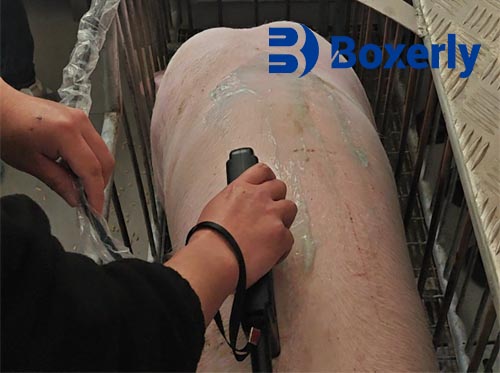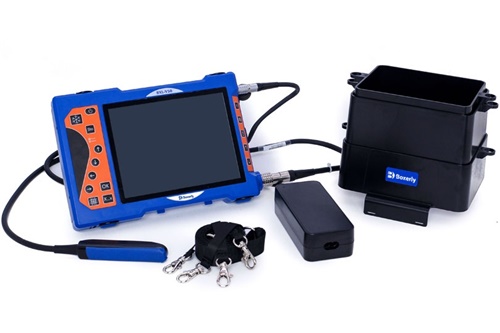Veterinary ultrasound equipment is an essential diagnostic tool used across a variety of animal species—from cattle and pigs to horses and companion animals. These devices, often exposed to challenging on-farm environments, offer critical insights into reproduction, fat deposition, muscle development, organ health, and pregnancy status. However, while much attention is given to their function during use, it’s equally important to understand how to properly store them during periods of inactivity. In this article, I will share best practices for storing veterinary ultrasound machines based on both practical farm experience and international veterinary standards, ensuring their longevity, performance, and safety.

Why Proper Storage Matters
Ultrasound equipment represents a significant financial investment for livestock producers and veterinarians alike. Devices like portable Doppler ultrasound machines or B-mode systems are technologically advanced and contain delicate components such as probes, LCD screens, and sensitive transducers. When improperly stored, these components are vulnerable to environmental damage, power degradation, and microbial contamination—issues that may lead to inaccurate readings, shortened lifespan, and costly repairs.
From the perspective of many Western veterinary practices, equipment maintenance—especially during idle periods—is considered part of biosecurity and animal welfare standards. Storing ultrasound machines correctly not only ensures device readiness but also protects animal health by guaranteeing diagnostic accuracy when it’s needed most.
General Principles of Ultrasound Storage
1. Clean Before Storing
Before putting any ultrasound machine into storage, it should be thoroughly cleaned and disinfected. In veterinary settings, probes often come into contact with body fluids or animal skin, increasing the risk of bacterial buildup.
Use manufacturer-approved disinfectants to clean probes and surfaces.
Dry thoroughly—moisture left behind can lead to mold growth or damage internal electronics.
Avoid alcohol-based cleaners on LCD screens or rubber components, as these can degrade material integrity over time.
According to guidelines shared by veterinary technicians in the American Association of Bovine Practitioners (AABP), meticulous cleaning prevents the formation of residues that can interfere with the ultrasound’s image clarity during its next use.
2. Store in a Controlled Environment
One of the most common mistakes is storing ultrasound machines in barns, trailers, or rooms without temperature or humidity control.
Ideal temperature: Between 10°C and 25°C (50°F to 77°F)
Humidity level: Below 60%
Avoid freezing temperatures—they can damage lithium-ion batteries and LCD components.
Avoid extreme heat—it can deform plastics and shorten the lifespan of circuit boards.
In Scandinavian countries, for instance, where winters are harsh, mobile veterinary units often include climate-controlled cabinets for storing diagnostic tools such as ultrasound machines.

3. Protect Against Dust and Pests
Dust, insects, and small rodents are hidden enemies of stored equipment. Even small particles can clog vent holes and cause overheating when the machine is restarted.
Store in sealed, dust-proof cases, ideally those provided by the manufacturer.
Avoid floor-level storage where exposure to pests or flooding is more likely.
Check for damage regularly, especially in rural areas where storage rooms are often multi-purpose spaces.
Devices like the BXL-V50 veterinary ultrasound scanner are designed with waterproof and dustproof ratings (e.g., IP56), but even such ruggedized equipment benefits from an added layer of protection when not in use.
Storage of Probes: The Most Delicate Component
The ultrasound probe is arguably the most sensitive part of the device. It contains piezoelectric crystals that generate and receive sound waves and are prone to damage from pressure, impact, or prolonged exposure to chemicals.
International best practices for probe storage include:
Never wrap the probe cable tightly around the handle or body.
Avoid kinking or bending the cable, which can cause internal wire breakage.
Use a probe holder or hang vertically in a clean, padded container.
Keep away from direct sunlight, which can degrade the plastic sheath over time.
In equine practices across the UK, veterinary surgeons often store their probes in medical-grade silicone racks, reducing pressure points and minimizing contamination risks.
Battery Storage and Maintenance
Many portable veterinary ultrasounds run on lithium-ion batteries that degrade if improperly stored. To ensure battery health during idle months:
Charge the battery to around 50-70% before long-term storage.
Avoid fully depleting or overcharging the battery.
Check and recharge every 1–2 months, even if not in use.
Store batteries in a cool, dry place, away from direct heat sources or sunlight.
Some systems, like the BXL-V50, feature smart charging indicators and built-in battery protection circuits, making them more resilient. Nonetheless, preventive care is still required to keep the battery functioning optimally for several years.

Software and Firmware Considerations
veterinary ultrasound machines often include embedded software for image capture, measurement, and storage. When stored for a long time:
Back up patient or herd data before storage.
Keep firmware updated to avoid startup errors when turning the system back on.
Record the last calibration date—this helps plan for re-calibration upon return to use.
In U.S. and European livestock operations where herd health monitoring is highly regulated, failing to keep devices updated can delay inspections or audits, especially if ultrasound reports are part of traceability protocols.
Storage During Farm Downtime or Off-Season
In some operations—such as seasonal breeding farms or rotational grazing systems—ultrasound may only be used part of the year. In such cases, the off-season storage should follow a checklist format:
✅ Clean and disinfect thoroughly
✅ Remove or recharge the battery
✅ Store in original hard case or padded box
✅ Place silica gel packs inside case to absorb moisture
✅ Label the equipment with last usage and next inspection date
✅ Notify all staff not to move or repurpose storage boxes
Veterinary technicians in Australian sheep stations recommend even taping a printed user manual to the case to ensure quick setup when reactivating after months of disuse.
Educating Farm Staff and Technicians
Even the best storage protocols can fail if not understood by all team members. That’s why veterinarians in Canada and the U.S. often run short “tech care workshops” during off-seasons, teaching farmhands:
How to store probes correctly
How to interpret charging lights
How to recognize early signs of machine degradation
How to transport equipment safely
Some veterinary ultrasound providers even offer certification in equipment handling, which helps standardize practices across different farms and clinics.
Insurance and Service Contracts
As part of storage best practices, ultrasound owners should also:
Ensure insurance covers damage during idle storage
Keep a record of all maintenance and cleaning activities
Maintain an active service contract or warranty
In Europe, veterinary cooperatives often negotiate shared service contracts with ultrasound manufacturers to cover multiple units, especially during non-peak seasons.
Conclusion
Veterinary ultrasound devices are precision instruments that require care even when not in use. Whether you're a livestock farmer, a veterinary technician, or an animal breeder, understanding how to store your ultrasound equipment properly can significantly extend its life, ensure diagnostic accuracy, and reduce repair costs.
By applying internationally recognized best practices—such as climate-controlled storage, probe protection, battery maintenance, and staff education—you can be confident your equipment will be ready the moment you need it.
While models like the BXL-V50 offer enhanced durability and long battery life, no device is immune to poor storage conditions. Invest a little time in proper storage today, and you’ll save a great deal of time, money, and stress down the road.
Reference Sources:
American Association of Bovine Practitioners (AABP). (2022). Ultrasound Equipment Care Guidelines. https://www.aabp.org
Veterinary Imaging Standards – Europe. (2023). Veterinary Device Handling Manual. https://www.fecava.org
Royal Veterinary College London. (2021). Storage of Veterinary Imaging Equipment in Mixed Practices. https://www.rvc.ac.uk
AgriHealth New Zealand. (2023). Best Practice in Veterinary Ultrasound Storage. https://www.agrihealth.co.nz
VetPractice Magazine. (2022). Off-Season Ultrasound Care Tips. https://www.vetpracticemag.com.au
tags:
Text link:https://www.bxlultrasound.com/ns/847.html


